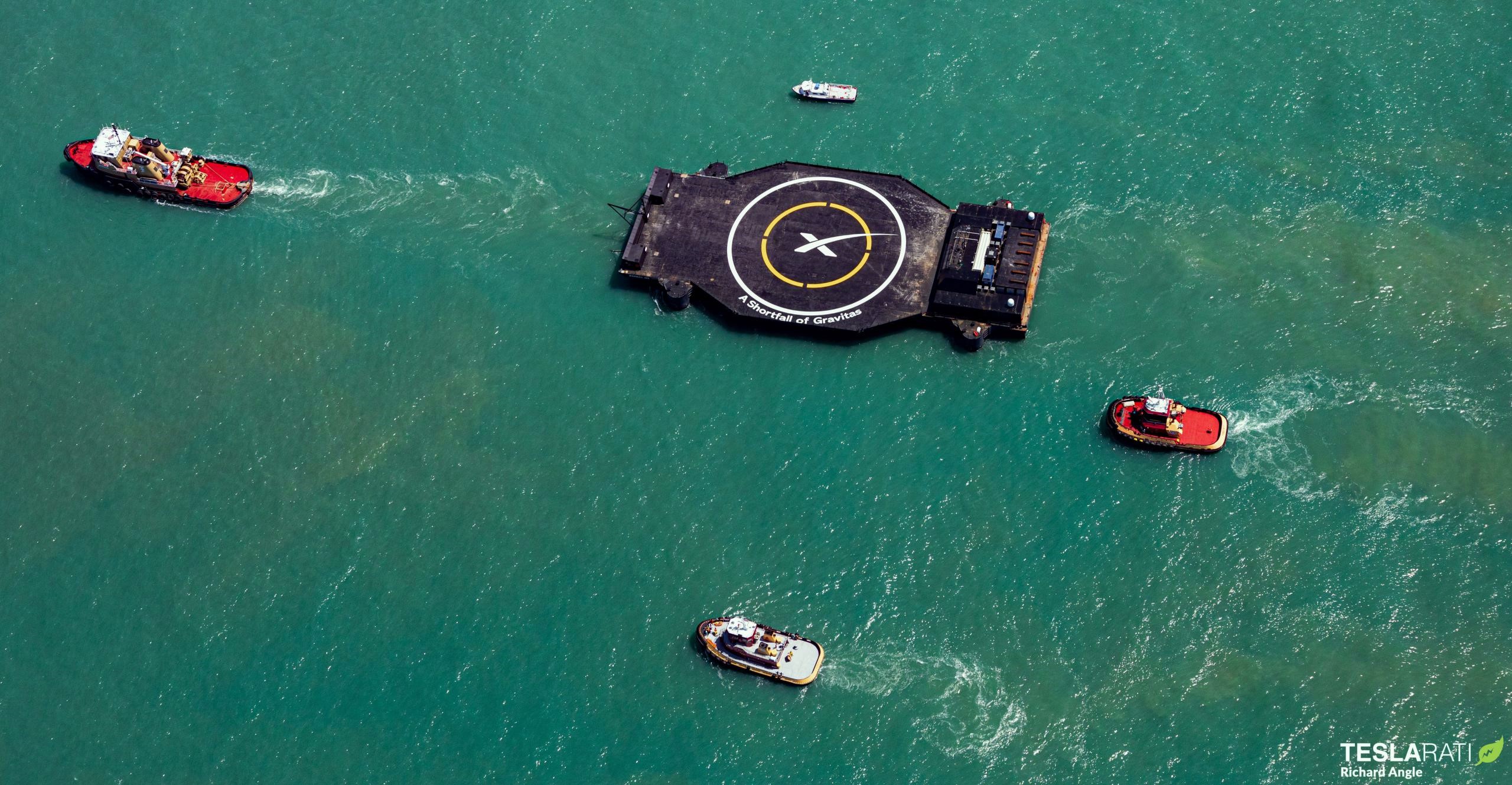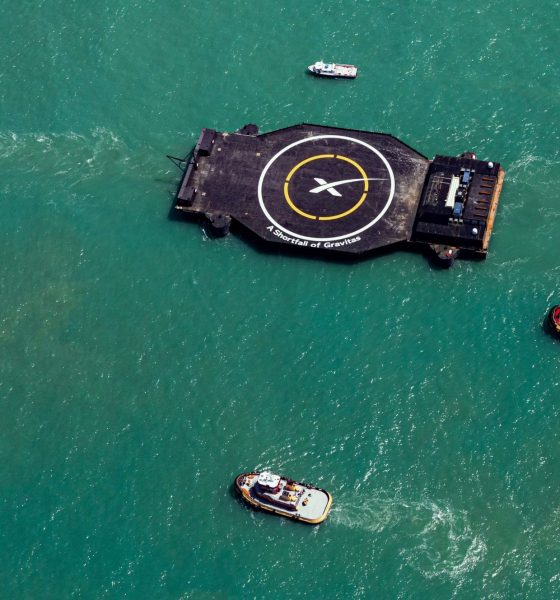

News
SpaceX drone ship leaves port for Starlink mission during a Falcon 9 launch
In preparation for SpaceX’s next launch, drone ship A Shortfall Of Gravitas (ASOG) was spotted departing Port Canaveral in the middle of the company’s second Falcon 9 launch and landing this month.
Rideshare mission Transporter-3 lifted off at 10:25 am EST on Thursday, January 13th and delivered 105 small satellites to orbit without issue, completing the second of five SpaceX launches planned for the first month of 2022. Thanks to its relatively light payload, the mission’s Falcon 9 booster was able to boost all the way back to Cape Canaveral for its landing. Ten minutes before Falcon 9 lifted off, SpaceX drone ship ASOG left its Port Canaveral berth, timing its departure such that the vessel was towed past fans and media members there to watch Transporter-3 a matter of seconds after Falcon 9 B1058 stuck its tenth landing just six miles (9.5 km) to the north.
The day before Transporter-3, FAA and Coast Guard notices revealed that SpaceX was aiming to launch its third mission of the month on the evening of Monday, January 17th. Launch photographer Ben Cooper backed up those notices soon after, confirming SpaceX’s plans to launch another batch of Starlink satellites (likely Group 4-6) no earlier than (NET) 7:26 pm EST. Starlink 4-6 will likely mirror 4-5 and carry ~49 Starlink V1.5 satellites to low Earth orbit, using an odd slightly southeastern trajectory to allow both the booster and payload fairing to land near the Bahamas.
During SpaceX’s Starlink 4-5 webcast, an engineer standing in as its host revealed that the purpose of its unusual trajectory and inefficient dogleg maneuver was to increase the odds of successful booster and fairing recovery by landing in a region of the sea that tends to be calmer in the winter. The tradeoff: to get there, Falcon 9 has to perform a slight dogleg maneuver (a bit like a mid-flight right turn), consuming more propellant and thus forcing SpaceX to remove 4 Starlink satellites from the nominal payload of 53. That increases the relative cost of each southerly Starlink launch by about 8% – an inefficiency that SpaceX clearly views as preferable to the risk of losing a Falcon 9 booster (worth $30-40M) or fairing ($2-3M per half) to the ocean.
Much like the first shell of SpaceX’s first 4408-satellite Starlink constellation, which SpaceX mostly completed last year, “Group 4” refers to an almost identical shell of 1584 satellites that will operate at a slightly (0.3%) different inclination and slightly (10 km; 2%) lower orbit. With 49-53 satellites on each mission, it will take SpaceX another 26-29 Falcon 9 launches to complete the new shell if every satellite works as planned.
If, as SpaceX’s plans for January suggest, the company’s Starlink V1.5 output has recovered to Starlink V1.0 levels (120-180+ satellites per month) after a five to six-month drought in H2 2021, SpaceX could more or less complete Shell 4 by the end of 2022 if it can average two Starlink launches per month for the rest of the year. January 2022 bodes well for that prospect, as SpaceX intends to conduct a third Starlink launch (4-7) near the end of the month if it can launch Starlink 4-6 and Italian Earth observation satellite CSG-2 within a few days of January 17th and January 27th.

News
Tesla FSD fleet is nearing 7 billion total miles, including 2.5 billion city miles
As can be seen on Tesla’s official FSD webpage, vehicles equipped with the system have now navigated over 6.99 billion miles.

Tesla’s Full Self-Driving (Supervised) fleet is closing in on almost 7 billion total miles driven, as per data posted by the company on its official FSD webpage.
These figures hint at the massive scale of data fueling Tesla’s rapid FSD improvements, which have been quite notable as of late.
FSD mileage milestones
As can be seen on Tesla’s official FSD webpage, vehicles equipped with the system have now navigated over 6.99 billion miles. Tesla owner and avid FSD tester Whole Mars Catalog also shared a screenshot indicating that from the nearly 7 billion miles traveled by the FSD fleet, more than 2.5 billion miles were driven inside cities.
City miles are particularly valuable for complex urban scenarios like unprotected turns, pedestrian interactions, and traffic lights. This is also the difference-maker for FSD, as only complex solutions, such as Waymo’s self-driving taxis, operate similarly on inner-city streets. And even then, incidents such as the San Francisco blackouts have proven challenging for sensor-rich vehicles like Waymos.
Tesla’s data edge
Tesla has a number of advantages in the autonomous vehicle sector, one of which is the size of its fleet and the number of vehicles training FSD on real-world roads. Tesla’s nearly 7 billion FSD miles then allow the company to roll out updates that make its vehicles behave like they are being driven by experienced drivers, even if they are operating on their own.
So notable are Tesla’s improvements to FSD that NVIDIA Director of Robotics Jim Fan, after experiencing FSD v14, noted that the system is the first AI that passes what he described as a “Physical Turing Test.”
“Despite knowing exactly how robot learning works, I still find it magical watching the steering wheel turn by itself. First it feels surreal, next it becomes routine. Then, like the smartphone, taking it away actively hurts. This is how humanity gets rewired and glued to god-like technologies,” Fan wrote in a post on X.
News
Tesla starts showing how FSD will change lives in Europe
Local officials tested the system on narrow country roads and were impressed by FSD’s smooth, human-like driving, with some calling the service a game-changer for everyday life in areas that are far from urban centers.

Tesla has launched Europe’s first public shuttle service using Full Self-Driving (Supervised) in the rural Eifelkreis Bitburg-Prüm region of Germany, demonstrating how the technology can restore independence and mobility for people who struggle with limited transport options.
Local officials tested the system on narrow country roads and were impressed by FSD’s smooth, human-like driving, with some calling the service a game-changer for everyday life in areas that are far from urban centers.
Officials see real impact on rural residents
Arzfeld Mayor Johannes Kuhl and District Administrator Andreas Kruppert personally tested the Tesla shuttle service. This allowed them to see just how well FSD navigated winding lanes and rural roads confidently. Kruppert said, “Autonomous driving sounds like science fiction to many, but we simply see here that it works totally well in rural regions too.” Kuhl, for his part, also noted that FSD “feels like a very experienced driver.”
The pilot complements the area’s “Citizen Bus” program, which provides on-demand rides for elderly residents who can no longer drive themselves. Tesla Europe shared a video of a demonstration of the service, highlighting how FSD gives people their freedom back, even in places where public transport is not as prevalent.
What the Ministry for Economic Affairs and Transport says
Rhineland-Palatinate’s Minister Daniela Schmitt supported the project, praising the collaboration that made this “first of its kind in Europe” possible. As per the ministry, the rural rollout for the service shows FSD’s potential beyond major cities, and it delivers tangible benefits like grocery runs, doctor visits, and social connections for isolated residents.
“Reliable and flexible mobility is especially vital in rural areas. With the launch of a shuttle service using self-driving vehicles (FSD supervised) by Tesla in the Eifelkreis Bitburg-Prüm, an innovative pilot project is now getting underway that complements local community bus services. It is the first project of its kind in Europe.
“The result is a real gain for rural mobility: greater accessibility, more flexibility and tangible benefits for everyday life. A strong signal for innovation, cooperation and future-oriented mobility beyond urban centers,” the ministry wrote in a LinkedIn post.
News
Tesla China quietly posts Robotaxi-related job listing
Tesla China is currently seeking a Low Voltage Electrical Engineer to work on circuit board design for the company’s autonomous vehicles.

Tesla has posted a new job listing in Shanghai explicitly tied to its Robotaxi program, fueling speculation that the company is preparing to launch its dedicated autonomous ride-hailing service in China.
As noted in the listing, Tesla China is currently seeking a Low Voltage Electrical Engineer to work on circuit board design for the company’s autonomous vehicles.
Robotaxi-specific role
The listing, which was shared on social media platform X by industry watcher @tslaming, suggested that Tesla China is looking to fill the role urgently. The job listing itself specifically mentions that the person hired for the role will be working on the Low Voltage Hardware team, which would design the circuit boards that would serve as the nervous system of the Robotaxi.
Key tasks for the role, as indicated in the job listing, include collaboration with PCB layout, firmware, mechanical, program management, and validation teams, among other responsibilities. The role is based in Shanghai.
China Robotaxi launch
China represents a massive potential market for robotaxis, with its dense urban centers and supportive policies in select cities. Tesla has limited permission to roll out FSD in the country, though despite this, its vehicles have been hailed as among the best in the market when it comes to autonomous features. So far, at least, it appears that China supports Tesla’s FSD and Robotaxi rollout.
This was hinted at in November, when Tesla brought the Cybercab to the 8th China International Import Expo (CIIE) in Shanghai, marking the first time that the autonomous two-seater was brought to the Asia-Pacific region. The vehicle, despite not having a release date in China, received a significant amount of interest among the event’s attendees.








